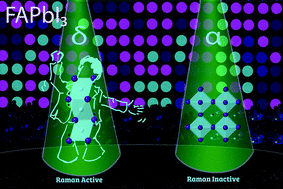Raman spectroscopy insights into the α- and δ-phases of formamidinium lead iodide (FAPbI3)†
Abstract
Solar perovskites have received phenomenal attention and success over the past decade, due to their high power conversion efficiencies (PCE), ease of fabrication and low cost which has enabled the prospect of them being a real commercial contender to the traditional silicon technology. In one of the several developments on the archetypal MAPbI3 perovskite absorber layer, FAPbI3 was found to obtain a higher PCE, likely due to its more optimum band gap, with doping strategies focusing on the inclusion of MA+/Cs+ cations to avoid the unfavourable phase transformation to a photoinactive phase. To better understand the phase change from the photoactive cubic (Pm![[3 with combining macron]](https://www.rsc.org/images/entities/char_0033_0304.gif) m) black (α) phase to the unwanted photoinactive (P63/mmc) yellow (δ) phase, we make use of variable temperature Raman spectroscopy to probe the molecular species and its relationship to the inorganic framework. We show for the first time there to be no Raman active modes for the α phase up to 4000 cm−1, which can be correlated to the Pm
m) black (α) phase to the unwanted photoinactive (P63/mmc) yellow (δ) phase, we make use of variable temperature Raman spectroscopy to probe the molecular species and its relationship to the inorganic framework. We show for the first time there to be no Raman active modes for the α phase up to 4000 cm−1, which can be correlated to the Pm![[3 with combining macron]](https://www.rsc.org/images/entities/char_0033_0304.gif) m cubic symmetry of that phase. Our detailed studies suggest that previous reports of the observation of Raman peaks for this phase are likely associated with degradation reactions from the localised laser exposure and the formation of Raman active lead oxide. In addition, we have identified water as a contributing factor to the transformation, and observed a corresponding signal in the Raman spectra, although confirmation of its exact role still remains inconclusive.
m cubic symmetry of that phase. Our detailed studies suggest that previous reports of the observation of Raman peaks for this phase are likely associated with degradation reactions from the localised laser exposure and the formation of Raman active lead oxide. In addition, we have identified water as a contributing factor to the transformation, and observed a corresponding signal in the Raman spectra, although confirmation of its exact role still remains inconclusive.



 Please wait while we load your content...
Please wait while we load your content...